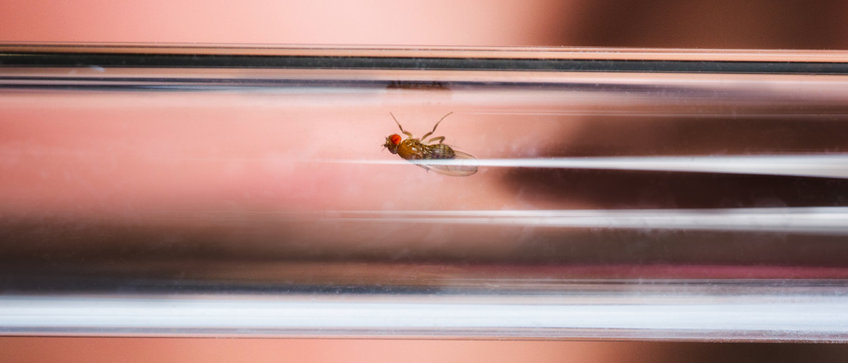
Behavioral Assays
We use different assays to test for olfactory guided behavior:
The Flywalk
This system automtically screens olfactory responses of 15 individual flies to up to 8 odors and all potential mixtures of those odors. In short, the flies are placed in 15 aligned glass tubes and under red light XY positions of the flies are monitored continuously by an overhead camera.
The flies are continuously exposed to a humidified airflow and are repeatedly presented with pulses of various olfactory stimuli at interstimulus intervals of 90 s. Attractive odors provoke upwind movement of the flies, while repellent odors provoke no or downwind movement.
As flies are allowed to distribute freely within their glass tubes, they may encounter the odor pulse at different times. This is compensated for by calculating the time of odor encounter for each individual tracking event based on the X position of the fly, system intrinsic delay, and airspeed.
Flywalk does not only allow to screen the valence of many odors in many flies, but also provides detailed information about response latency (the most attractive odorants result in upwind movement already 200 ms after stimulus arrival) and response strength. For details see
Steck et al. Scientific reports. 2012
Thoma et al. J. exp. Biol. 2014
Thoma et al. JoVE. 2015
The Trap Assay
This assay provides a quick and easy method to test the valence of individual odorants in Drosophila. An odor-containing and a solvent containing trap made from 30-mL transparent plastic vials are placed into a 500-ml box with ventilation holes in the lids. Thirty 4- to 5-d-old starved flies are placed in each test box. Experiments are carried out in a climate chamber (25 °C, 70% humidity, 12:12 light:dark cycle). The number of flies inside and outside the traps is counted after 24 h. The attraction index oft he odorant is calculated as (O − C)/T, where O is the number of flies in the odorant trap, C is the number of flies in the control trap, and T is the total number of tested flies. For example studies using the trap assay see
Knaden et al. Cell reports. 2012
Keesey et al. Chemical ecology. 2016
The Mating Assay
This assay is used to test for courtship deficiencies in flies (that e.g. lack neuronal circuits involved in pheromone detection). It also can be used to test for courtship-related significance of specific odorants by testing courting flies in presence or absence of these odorants. We have currently established a new setup that allows to record from up to twenty courtship experiments in parallel.
For example studies using the mating assay see Dweck et al. PNAS. 2015
The Wind Tunnel Assay
We use large wind tunnels to test for feeding and oviposition preferences in the sphingid moth Manduca sexta. Moths are released within the downwind part of the wind tunnel (2.5m*1m*1m) and their responses to odor plumes are recorded by an automatic 3D-tracking system. As we have established the 3-dimensional plume structure within the tunnel, we are always informed about the sensory input received by a flying moth. External plant chambers allow us to provide the moth with on-site- collected head spaces from e.g. nectar providing flowers or potential host plants.
For example studies using the wind tunnel see
Haverkamp et al. eLife. 2016
Haverkamp et al. Nature Communications. 2016